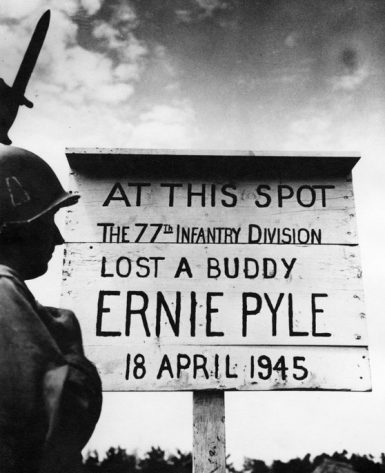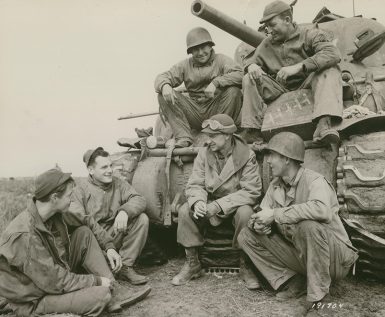Events mark 70th anniversary of Pyle’s death

Events as near as campus and as far away as Hawaii will mark the 70th anniversary of the death of Pulitzer Prize-winning World War II correspondent Ernie Pyle.
The IU alumnus and one-time Indiana Daily Student editor was killed April 18, 1945, by machine-gun fire on Ie Shima, a small island in the Pacific, where he was reporting for Scripps-Howard newspapers.
At that time, Pyle’s columns had engaged millions of readers around the world due to his style of reporting from soldiers’ points of view, and obituaries about his life reflected both his popularity and the humanity in his reporting.
Three events are set for April 18:
- On campus, Journalism Alumni Board members will gather at 12:15 p.m. at the Ernie Pyle sculpture near Franklin Hall to present flowers in memoriam. A student will read one of Pyle’s columns and the group will observe a moment of silence. Anyone may attend the brief ceremony.
- In Pyle’s hometown of Dana, Indiana, the Ernie Pyle World War II Museum will reopen for the season with a tribute to Pyle hosted by the Friends of Ernie Pyle organization. The ceremony will start at 1 p.m. April 18 and will feature a 21-gun salute, a recitation of Pyle’s last column and a lookalike contest for all ages. Lecturer Bonnie Layton and a small group of students plan to attend the Dana celebration.
- In Honolulu, Hawaii, the Ernie Pyle Legacy Foundation, established last year by some of Pyle’s relatives, will host a commemoration at Pyle’s grave at the National Memorial of the Pacific. Associate Professor Emeritus Owen Johnson is scheduled to speak.

“Seventy years after his death, Ernie Pyle remains a model for high quality reporting and writing,” Johnson said. “This anniversary of his death gives us the opportunity not only to honor him, but also to remember the lessons he can teach us.”
Members of Pyle’s family established the Ernie Pyle Legacy Foundation to ensure that those lessons aren’t forgotten. Director Jerry Maschino said the family wanted the foundation to represent not only Pyle’s time during the war, but his entire life.
“Many articles and books have been written, but it takes more to carry on a legacy,” he said by phone from Hawaii. “The foundation is proud to take ownership of this journey. We as descendants, and with the help of the others, started the foundation to provide a broader base and look at different aspects of Ernie’s life.”
During its ceremony, the foundation will dedicate a memorial rock to the U.S. Infantry and to war correspondents, with an inscription written by retired lecturer Dennis Elliott, who has been a volunteer with the organization.
Students in the Agency 7 capstone class for students in advertising and public relations have assisted the foundation with media kits and other materials. A group of five seniors — Josie Tanner, Caroline Hoven, Derek Scringer, Maegan Shinkle and Alexea Candreva — have been working closely with Maschino. They developed materials to inform media in Indiana and Hawaii, as well as New Mexico, where Pyle and his wife lived for several years.
The leaders at the Ernie Pyle World War II Museum in Dana have had many years of experience operating a nonprofit dedicated to Pyle’s legacy. But they share the same sentiment as those who recently launched the foundation.

“We hope at the Ernie Pyle WWII Museum that folks come away knowing who Ernie Pyle was and how important his columns were to the people during WWII,” said Cynthia Myers, president of the Friends of Ernie Pyle group. “We can keep his memory and history for generations to come. He was very important to our community of Dana, Indiana — and not just Dana, but to people all over the world.”
Johnson said that Pyle would have been embarrassed by all of the attention.
“He recognized that what he wrote meant so much to the people who read it,” he said. “Almost all of the troops he wrote about would never have considered themselves heroes. Like them, he would have felt he was just doing his duty. And like too many of those just doing their duty, he gave his life.”
About Ernie Pyle:

Pyle was born in Dana, Indiana, and attended Indiana University, where he studied journalism and edited the Indiana Daily Student. He left IU one semester before he would have graduated for a newspaper job in Laporte, Indiana, then went to The Washington Daily News in Washington, D.C.
By 1928, he was covering aviation, then a relatively new industry. In 1935, he took on the job of roving reporter, traveling across the country to write about unusual people and places. This writing about people’s experiences honed the skills that would make him a beloved columnist just a few years later.
In 1942, Pyle began covering the war, connecting soldiers in the European theater to the readers back home. He lived with soldiers, even spending time in the trenches with them, and told the story of the war experience through their eyes.
As a result of his reporting, Congress passed “The Ernie Pyle Bill” in 1944 to secure “fight pay” for soldiers in combat. His work influenced journalism: He helped alter censorship laws so that he could use soldiers’ names in the stories he wrote. In 1944, he won the Pulitzer Prize for correspondence.

